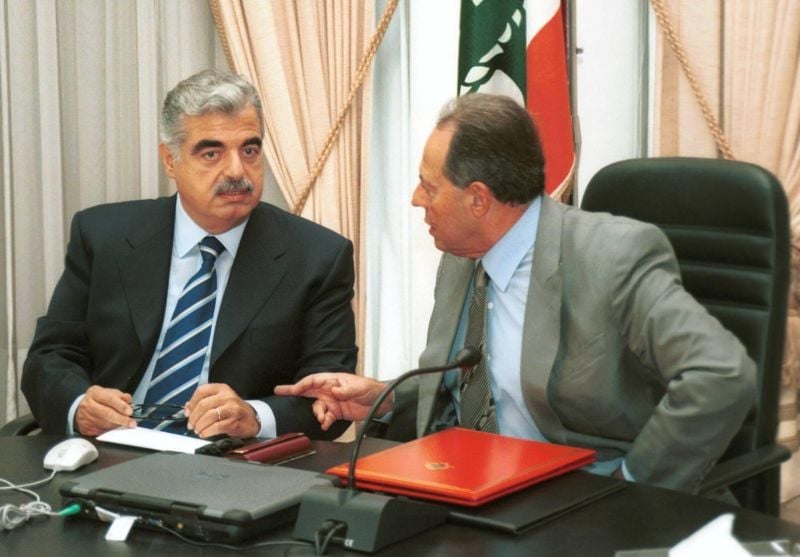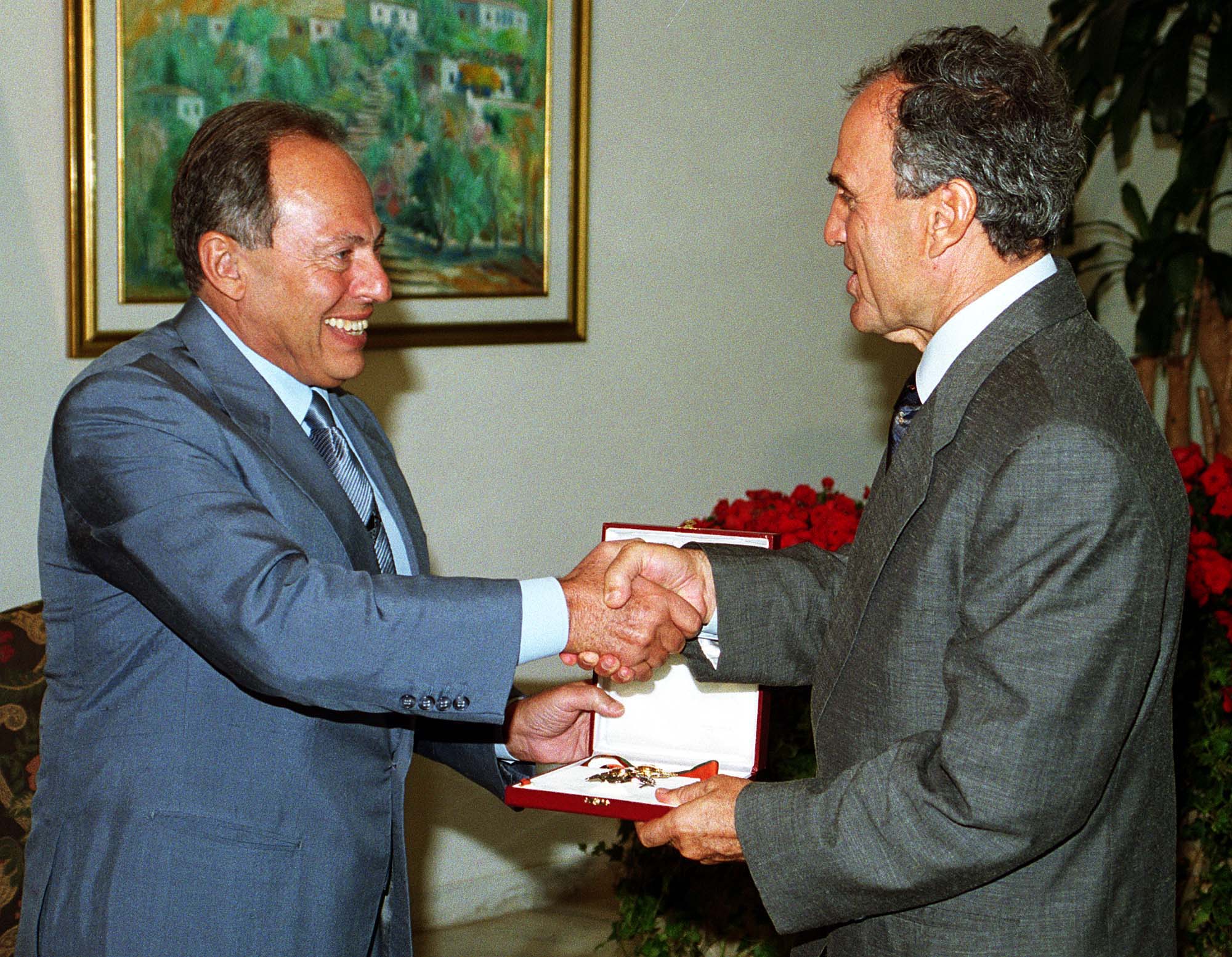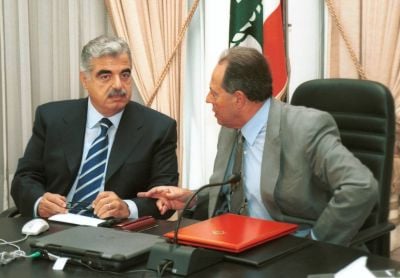
Rafik Hariri and Emile Lahoud in the Lebanese cabinet. (Credit: L'Orient-Le Jour archives)
Emile Lahoud, who had served as army chief since 1990, became president in November 1998, at a time when Syria was attempting to consolidate its control over Lebanon.
Lahoud was part of a group of Lebanese personalities and officials with close ties to Bashar al-Assad, who succeeded his father Syrian President Hafez al-Assad upon the latter’s death in 2000.
In 1995, when Hafez al-Assad endorsed the extension of Elias Hrawi’s mandate, he set two conditions: that the extension only be for three years and that Emile Lahoud remain in command of the Lebanese Army during this period.
The message was clear: Damascus was preparing everyone for the idea that Lahoud would succeed Hrawi.
In his memoirs, Hrawi recalls this period of time. He recounts that during a meeting with Hafez al-Assad on Nov.5, 1998, the Syrian president told him that Lahoud would succeed him as head of state. Lahoud was elected in the midst of efforts to ensconce Bashar al-Assad in the Syrian presidency. Lebanon had to be a “safe zone” for Assad junior.
From the outset, Lahoud's mandate was part of an effort to settle scores with those close to the old Syrian guard, notably Syrian Vice-President Abdel Halim Khaddam and Chief of Staff Hikmat Chehabi.
His mandate also ushered in the tug of war between the new Lebanese president and then Prime Minister Rafik Hariri.
Damascus had consistently refused to acknowledge Hariri as a Sunni leader. Syria regarded him as the head of government with a well-defined role, rather than a leader involved in political and security matters.
For the Syrian regime, Hariri’s authority was confined to the economy and finance.
After the election of Hrawi in 1990, the new president proposed appointing Hariri as prime minister. The Syrian regime attempted to stall the appointment on two occasions.
Hariri played a facilitating role in the conclusion of the Taif Agreement (1989) and was known for his closeness to Saudi Arabia, whose financial assistance was necessary to revive the Lebanese economy.
Syria tried to block Hariri’s appointment by first imposing Omar Karameh to the post and by then making Rashid al-Solh prime minister after Karameh resigned.
However, in the summer of 1992, the economy slipped and the lira reached LL3,000 to the dollar. Only then did Hafez al-Assad finally yield to Hrawi’s appeals and Lebanon’s financial and economic imperatives.
During Lahoud’s term, the political struggle took on different forms amidst the increasingly apparent differences between Syria and Saudi Arabia over the region’s main orientations.
There was a growing tendency among Bashar al-Assad and his supporters to view Sunnis as a threat to the Syrian regime. Thus, it was necessary to weaken Hariri in Lebanon.
At the end of 1998, Lahoud held mandatory parliamentary consultations to appoint a prime minister and form the first government under his mandate.
The majority of MPs voted for Hariri, much to the dismay of Lahoud and Assad.
In an attempt to set a trap for the Saudi-linked billionaire, Lahoud seized the votes of 31 pro-Syrian MPs whom he claimed “gave” their ballots to him, allowing the president to use them as he wished.
Lahoud then met with Hariri and told him that he would offer him these 31 votes. Had he accepted the offer, the prime minister would have been immediately reduced to being the president’s subordinate. Instead, Hariri saw through the trap and turned down Lahoud’s offer, stating that his approach was unconstitutional.
 President Emile Lahoud presenting Ghazi Kanaan, a political strongman of Syria in Lebanon, with the Grand Cordon of the Order of the Cedar, on October 9, 2002, at Baabda Palace. (Credit: L'Orient-Le Jour archives)
President Emile Lahoud presenting Ghazi Kanaan, a political strongman of Syria in Lebanon, with the Grand Cordon of the Order of the Cedar, on October 9, 2002, at Baabda Palace. (Credit: L'Orient-Le Jour archives)
Tug of war
Stepping down as prime minister, Hariri joined the opposition and began to prepare for the 2000 elections.
The beginning of the new millennium was marked by major changes. Israel withdrew from the border strip it occupied in southern Lebanon on May 25, 2000. A few days later, Hafez al-Assad died and his son Bashar ascended to the presidency.
In Lebanon, the elections that September pitted two camps against each other: pro-Damascus and silent opponents.
The new Syrian regime was confident that its local allies would win a majority in Parliament, but that was not the case.
The parliamentary election resulted in a landslide victory for Hariri and the leader of the Progressive Socialist Party, Walid Joumblatt.
A few days after the vote, the Maronite bishops launched their famous appeal of Sept. 20, 2000, written by Maronite Patriarch Nasrallah Sfeir himself. The appeal called for the withdrawal of Syrian troops from Lebanon after the departure of the Israeli army.
It was the first time such a declaration had been made.
These events would encourage the gradual formation of a joint anti-Syria front among Christians, Sunnis and Druze. The first sign of this development was marked by the reconciliation between Christians and Druze in the Chouf, sealed between Patriarch Sfeir and Walid Joumblatt in August 2001.
Local and international efforts calling for Syria’s exit from Lebanon grew after the Sept. 11 attacks, notably after then-US President George W. Bush’s remarks listing both Iran and Syria in the so-called “axis of evil.”
In 2003, the US Congress passed the Syria Accountability and Lebanese Sovereignty Restoration Act.
At home, political efforts were in the works against the extension of Lahoud’s mandate, which dismayed Syria.
It was during this time that the disagreement between Damascus and Hariri became apparent.
Assad openly threatened Hariri.
“I will demolish Lebanon on your head and on Walid Joumblatt's head,” said Assad in one instance.
Assad's threats were also directed at figures involved in the opposition movement to the Syrian presence in Lebanon, from the Christian Qornet Shehwan Gathering to the (multi-religious) Bristol Gathering.
During their participation in the celebrations of the 60th anniversary of D-Dau on June 6, 2004, French and American presidents, Jacques Chirac and George W. Bush decided to work together to counter the Syrian plan to extend the Lahoud mandate scheduled for the end of the year.
Their agreement led to the adoption of Resolution 1559 by the United Nations Security Council in September, which called for the withdrawal of foreign forces from Lebanon and the disarmament of militias in the country.
Bashar al-Assad appeared to believe that keeping Lahoud in the Baabda presidential palace for another three years was vital to his survival.
As a result, he rejected international calls to hold a new election and accused Rafik Hariri of influencing the global community.
This created an atmosphere of direct opposition to Damascus within Lebanon, culminating in Hariri’s assassination on Feb. 14, 2005.
The political earthquake that followed, both domestically and internationally, was the beginning of the end of Syrian domination over Lebanon.
On March 14, almost a million Lebanese citizens marched in protest, demanding the immediate withdrawal of Syrian troops from their country.
On April 26, the Syrian withdrawal was officially announced, and a new era began.
At this point, Lahoud remained in the Baabda presidential palace, but his power was severely weakened. He was no longer in control of the political scene. His Syrian backers were defeated, and he was increasingly isolated.
Meanwhile, Hezbollah, which was joined by General Michel Aoun’s Free Patriotic Movement (FPM) in 2006, saw its influence increase significantly in the country.
As a result, political polarization was in full swing and led to a deadlock at the end of 2007 when Lahoud’s extended mandate expired.
The showdown between the “sovereignist” camp of March 14, led by Rafik Hariri’s son, Saad Hariri, and Hezbollah resulted in the latter’s acts of violence in West Beirut on May 7, 2008. The sequence ended with a shaky compromise reached in Doha.
The first step of the compromise was the election of Michel Sleiman, the head of the army, as the President of the Republic.
This article was originally published in French in L'Orient-Le Jour. Translation by Sahar Ghoussoub.
